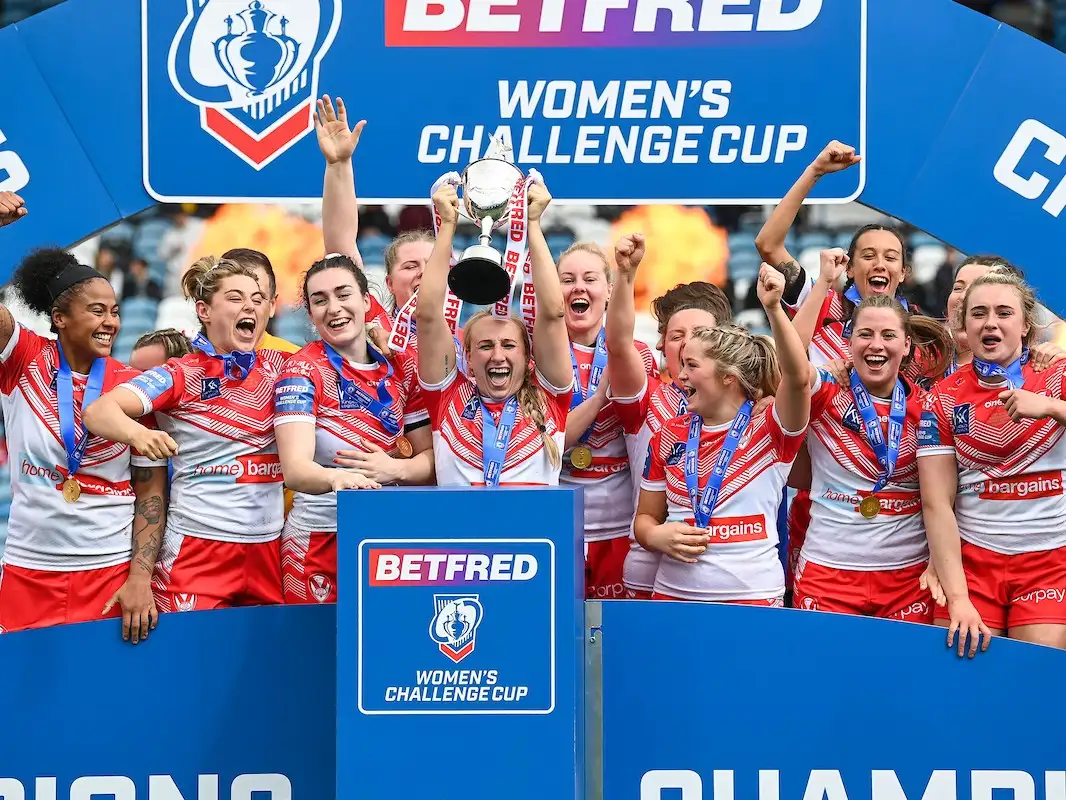Recordbreaking: An elite occasion for the women’s game amidst its growing pains

Photo: Craig Thomas/News Images
As St Helens lifted the Women’s Challenge Cup trophy in front of a women’s rugby league record crowd at Elland Road, supporters of the game were no doubt reflecting how far it had come.
In barely five years, the women’s game has gone from virtual anonymity to prime Saturday lunchtime billing on terrestrial television.
Viewership of Saints’ battling 18-8 win over Leeds peaked at 300,000, with an average of 200,000 throughout the 80 minutes.
Those figures will give great encouragement to the women’s game, especially heading in to the hotly-anticipated World Cup at the end of the year.
A crowd of 5,888 was credited with watching the women’s final – a record high in the UK – and while just how that was calculated on a day of three games is unknown, there was no doubting that the game caught the attention of those in the ground.
A gripping final
St Helens rocked up with an extraordinary record of not having conceded one point yet in five games in 2022, and on an unbeaten run that dates back to 2019, when Leeds beat them in the Super League play-offs.
Such has been the treble-winners dominance post-COVID, they were hot favourites and there may have been some fears a one-sided scoreline was in the offing; not ideal for such a prime billing spot.
There needn’t have been any worry. Leeds took the game to Saints and were excellent, particularly in the first half.
Some pointed to the fact that their narrow semi-final win over York had made them more battle-hardened than their counterparts, and that seemed evident early doors.
From the kick-off, where Courtney Winfield-Hill found touch off the bounce, Leeds fronted up. Eventual player of the match Zoe Hornby was a thorn to the Saints middles, and the wisely used interchanges – particularly Emma Lumley and Alexandra Barnes – kept the Rhinos on top.

The selection of Hannah Butcher at centre seemed to be a tactical masterstroke, as she largely kept the remarkably prolific England centre Amy Hardcastle at bay.
Georgia Roche and Winfield-Hill, an exciting half-back partnership, managed the game well offering pivots on both sides of the attack, with Saints struggling to exert the same control at the other end.
Hornby put Leeds ahead with the game’s first try and as the half went on, such was the promise showed by Leeds, that questions were asked whether they ought to have managed to establish a larger lead than they had.
That 6-0 lead became 8-4 at half-time, Leah Burke touching down for Saints before Winfield-Hill wisely slotted a penalty shortly before the hooter.
Burke’s try, off a well placed Zoe Harris kick, was one of the few times Saints had managed to end a set of six on their own terms in the half.
Interchange forward Vicky Whitfield, and tireless captain Jodie Cunningham, had done their bit in keeping them in the game up the middle.
It was the growing influence of England back-rower Emily Rudge, named on the bench from the start as she continues to return from injury, that swung the game in Saints’ favour.
Rudge, and 80-minute prop Chantelle Crowl, laid the platform for the field position that built pressure and forced Leeds into an error that enabled Eboni Partington to pounce for the first of her two tries prior to the game’s key moment.
Leeds opted to go for a tricky penalty, midway between the posts and the touchline, from 25 metres out, with Winfield-Hill dragging the kick wide of the uprights.
Saints rolled up the other end of the pitch and Cunningham crashed over to give Saints their first lead of the match, and Partington made sure late on.
Women’s rugby league growing pains
It was a fine game on an elite occasion for the women’s game, which is aware of its inevitable teething issues.
While the likes of Saints and Leeds, plus York and maybe one or two others, push forward full of international players who will surely give England a chance of winning the World Cup come the autumn, there is no hiding from the one-sided scorelines it creates.

Cunningham, the reigning Woman of Steel and highest profile English player in the women’s game now oversees its development in her role with the RFL.
The Saints skipper said: “I understand that it’s tough. Sometimes we have had one-sided games. I think the game is constantly developing and changes are constantly being made to help address some of that.
“It’s part of my job to bring these young girls up and show them what it’s like and help them on their journey.
“They’ll be 10 times the player that I am because as the women’s game grows and the more support it gets; with better facilities, coaching, all the backroom staff and the opportunities that are there now means that the current players who are getting better, more physical and more athletic.
“There’s more and more girls who go ‘that is brilliant, I want to be a part of that’ and start playing the game.
“So year on year, the standard is raised across the board, and some of these young girls now are absolutely going to be superstars.”
Increasing numbers
Participation is rightly the key priority for the women’s game, as more and more girls take up rugby league, and an increase in teams dilutes the talent across the leagues.
Castleford’s late withdrawal from Super League Group 1 has forced a late change to the make-up of the Women’s Super League, meaning the top ‘half’ will now consist of five teams and the bottom of seven teams.
The five top teams – Saints, Leeds, York, Wigan and last year’s Shield winners Huddersfield – will now play each other home and away with a revised fixture list due later this week.
The league meeting between Saints and Leeds will act as a double-header with the men’s Super League fixture at Headingley, and be televised live by Sky Sports.
Consumption of women’s sport continues to grow massively.
More than 15 million people watched three minutes or more of women’s sport coverage in the first quarter of 2022, up from 10.2m in 2019 and 5.06m in 2021.
Leeds head coach Lois Forsell understands their role in making that improvement for rugby league.
“The game is growing and growing, the athletes are getting better and better and they’re working harder and harder,” said Forsell.
“We need people to want to watch it week in, week out, and we need to be able to get the game to a point where it’s broadcast-able all the time on platforms like BBC and Sky.”
And while we wait for the number of competitive sides to increase, it’s important that the elite games live up to their billing – Saturday’s Women’s Rugby League Challenge Cup final certainly did.
REPORT: Leeds 8-18 St Helens: Saints win back-to-back Challenge Cups in front of record crowd



